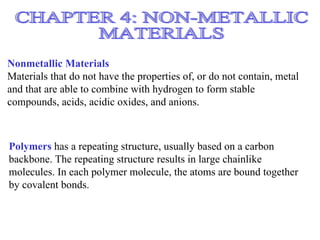
Ms chapter 4
- 1. Nonmetallic Materials Materials that do not have the properties of, or do not contain, metal and that are able to combine with hydrogen to form stable compounds, acids, acidic oxides, and anions. Polymers has a repeating structure, usually based on a carbon backbone. The repeating structure results in large chainlike molecules. In each polymer molecule, the atoms are bound together by covalent bonds.
- 3. Types of polymers • Linear polymers polyethylene, polyvinyl chhloride, polystyrene, nylon, teflon 2. Branched polymers elastomers or polymeric rubbers 3. Crosslinked polymers thermosetting polymers 4. Network polymers epoxies
- 4. Polymers are useful because they are: 3. lightweight 4. corrosion resistant 5. easy to process at low temperatures 6. inexpensive The mechanical properties of polymers: 10. low strength 11. high toughness The distinct properties of polymers is they are poor conductors of electricity and heat, which makes them good insulators.
- 5. Physical properties of polymers 2. Composed of very large molecules 3. Low stiffness/elasticity 4. Low tensile and compressive strengths 5. Deformation is sensitive to temperature 6. Crystalline structure 7. Low thermal and electrical conductivity – good conductor 8. Creep at room temperature 9. Low temperature makes plastics brittle 10. Plastic deformation
- 7. Thermoplastics 2. Soften when heated and harden when cooled 3. Varying degree of ductility 4. Can be recycled 5. Can not withstand high temperature Thermosets 2. Become permanently hard after the initial heating- cooling cycle 3. Brittle 4. Can not be recycled 5. Can withstand high temperature
- 8. EXAMPLE THERMOPLASTICS 1. Acrylic (Known also as PERSPEX) is the most common plastic used. It is purchased usually in the form of sheets and comes in a range of colours. It can be translucent (e.g. smoked), transparent or opaque. It is resistant to most acids and weather conditions. 2. Polyethylene or Polythene (PE) can be moulded into almost any form due to its excellent moulding qualities. Used for the production of bottles, bowls, toys, tube etc... It is available in large sheets. There are two types: High density which is rigid and hard, and low density which is tough and flexible. Machine parts are generally made from high density polystyrene whilst bottles are made from the low density polystyrene.
- 9. 3. Polyvinyl Chloride also known as PVC. It is a tough material which can be purchased as a hard material or alternatively a flexible form. It can be welded or bonded with an adhesive. It has a range of uses including water pipes, raincoats, long play records, coating on electrical wires and many more. 4. Polypropylene (PP) is used for carpet fibers, ropes, liquid containers (cup, buckets, tanks), pipes, etc 5. Polystyrene (PS) is used for pakaging foams, egg cartoons, light panels, electrical appliance components, etc
- 10. EXAMPLE THERMOSETTING PLASTICS 1. Many adhesives (glues) are thermosetting plastics. A good example is ‘Araldite’ which is an epoxy resin that hardens when a second chemical is added (a catalyst). It will bond most materials including woods and metals as well as some plastics. 2. Polyurethane. This forms the basis of many paints and varnishes because it is very tough and has water resistant qualities. 3. Melamine Formaldehyde is used in the production of plastic laminates because of its smooth surface and hygienic qualities. It is also used in electrical plugs and sockets because it can be cast and it is an excellent insulator. 4. Polyester resins. If resins are combined with a material such as fibre glass the result is a very tough material that can resist impact. This type of material is known as a glass reinforced plastic (GRP) and is used in car body repairs, sailing boats, corrugated sheet because of its lightness, toughness and resistance to water.
- 11. MORE USEFUL PLASTICS Styrofoam is a light-weight dense foam. It is easy to shape with saws, files and abrasive paper and is ideal as a model making material. Expanded Polystyrene is an efficient insulator used in cavity walls and as decorative tiles and covering on ceilings. It can also be used for basic model making. Nylon is used in engineering to make gears and bearings. It’s oily nature means that friction is reduced between moving parts made from nylon.